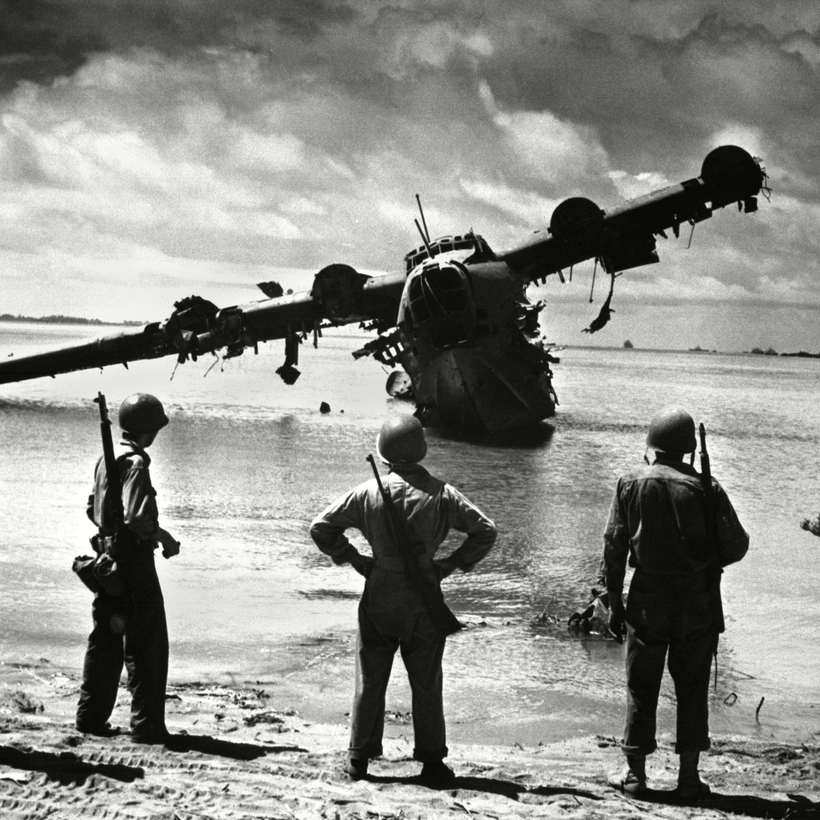By the summer of 1944, after two years of savagely fighting the Japanese, island by island, American forces had taken the Marianas, putting Tokyo within range of American bombers. The war in the Pacific should have been as good as done. Even the Japanese rulers knew they were defeated, lacking the resources to stop the American war machine from conquering their homeland.
But that does not mean the Japanese were willing to surrender. Rather, they were determined to die gloriously for the emperor. They would be gyokusai (smashed jewels), demonstrating their racial superiority and divine spirit.
On November 27, 1944, General Haywood “Possum” Hansell, the chief of the 21st Bomber Command, assigned to launch air raids against the Japanese home islands, was driving in a jeep along the Isley airfield on the island of Guam when a Japanese Zero fighter plane swooped in and strafed him. Hansell jumped out and scrambled into the bushes. But the attack was not over. “When the Japanese pilot had expended his ammunition, he cranked down his wheels and actually landed on Isley’s main runway,” writes Ian Toll in his magnificent saga of the last year of the Pacific war. “To Hansell’s amazement, the pilot leapt out of his cockpit with a pistol in his hand and fought a gun battle with American soldiers, who quickly killed him.”
To the Death
The Americans had long since learned to grudgingly admire as well as fear the refusal of Japanese soldiers to be taken prisoner. As early as Guadalcanal in the late summer of 1942, the Japanese had staged suicidal frontal attacks, and in October 1944, kamikaze planes began methodically targeting U.S. Navy warships. The Americans accommodated the Japanese death wish, sometimes with an avidity that verged on the ghoulish. After sinking the freighter Nitu Maru, the U.S. Navy submarine Wahoo surfaced and ran over one of the lifeboats, “knocking the survivors into the frigid sea,” writes Toll. “A 20 mm gun quickly killed the swimmers.” Watching the survivors of another sunken freighter cling to the wreckage, the sailors on the Wahoo taunted, “So solly, please!”

Toll does not tell these stories to suggest moral equivalence. The Japanese were routinely cruel as they pillaged their way through Southeast Asia and almost otherworldly in their lust for death. The Americans were compelled to ever more gruesome means to satisfy this desire, ultimately with two atom bombs. Was there another, less apocalyptic way? Twilight of the Gods, the final volume in Toll’s Pacific-war trilogy, every bit as captivating as his first two—Pacific Crucible (2011) and The Conquering Tide (2015)—strongly suggests not.
The Americans had long since learned to grudgingly admire as well as fear the refusal of Japanese soldiers to be taken prisoner.
Toll reminds us that the atomic bombings of Hiroshima and Nagasaki were not the most lethal attacks on Japan. The March 9–10, 1945, firebombing of Tokyo “may have killed more people (initially) than Hiroshima and Nagasaki combined. It was the most devastating air raid of the war, in either Europe or the Pacific,” writes Toll. “It left more dead than any other single military action in history.”
How many died? A hundred thousand men, women, and children, probably more. The citizens of Tokyo suffocated as the giant firestorm sucked the oxygen out of the air; they baked on the street and boiled in the rivers. But in the moment, the Japanese downplayed the holocaust. According to Toll, the local press “dwelled on the fact that the Imperial Palace had not been hit, and the emperor was unharmed.” At the end of March, Emperor Hirohito himself ventured out in a motorcade to look at the damage (16 square miles burned to the ground). Japanese citizens bowed and knew not to complain. The Kampetai—the secret police—were watching and listening. “Within earshot of neighbors and strangers, it was considered safest to say, ‘It doesn’t seem too bad,’” writes Toll.
From Samurais to Kamikazes
On August 9, 1945, the day the second atom bomb fell, on Nagasaki, Japan’s six-man Supreme War Council met to consider whether to surrender. By then Japan was so low on fuel that schoolchildren were scavenging for pine cones, to extract the flammable sap. The Russians had declared war on Japan the day before, and famine loomed. (Indeed, an American operation to mine Japan’s harbors, cutting off rice supplies, was straightforwardly called “Operation Starvation.”) Yet the vote on the ruling council was a tie, three to three. Half the leaders wanted to fight a “decisive battle” for better terms—no American occupation, no war-crime trials, and retention of the emperor.
After a brief pause, the American Army Air Force was getting ready to drop a third atom bomb. How could the Japanese rulers be so stubborn? In part, because they were afraid that if they showed any wavering, they would be assassinated by their own mid-level and junior officers, who for the past couple of decades or so had not hesitated to shoot their superiors, up to and including Japan’s prime ministers. In theory, the emperor was the commander in chief of the armed forces, but in practice he was cowed by his army and navy, whose leaders were in turn afraid of their own rabid men.
“Within earshot of neighbors and strangers, it was considered safest to say, ‘It doesn’t seem too bad.’”
A wonderful teller of war stories, Toll is also a shrewd cultural observer, and he brilliantly explains how the ancient samurai ethic was perverted by 20th-century militarists. Medieval samurai were brave, but they knew how to surrender with honor. The Japanese military, especially the army, twisted the warriors’ code—Bushido—to make soldiers into martyrs. Many of the foot soldiers of the Imperial Army were wanton killers—Toll’s account of the “sack of Manila,” in 1945, is harrowing and revolting. They were also absolutely unafraid to self-immolate.

For far too long, Emperor Hirohito allowed himself to be used by the military. But at the very end, with his country in flames and his throne in jeopardy, he stepped in to order the military to lay down their arms. Speaking in an ancient-court Japanese that many of his own people could barely understand, Hirohito did not actually use the word “surrender.” Rather, in his pre-recorded radio address to the nation on August 14, he declared, with epic understatement, “The war situation has developed not necessarily to Japan’s advantage.” The night before, the emperor had barely avoided a coup d’état. Mutinous army officers had run through the palace, looking for the emperor’s official recording, in order to shatter it before the scheduled broadcast.
Understandably, the victorious Americans worried that some, perhaps many, Japanese would never give up. A few last kamikazes flew, and there was some tough talk by younger officers. The Atsugi air base, outside Tokyo, was a particular hotbed of die-hard insurrectionists. Would they ambush the vanguard of the American occupation forces? As his plane approached Atsugi, the American supreme commander, General Douglas MacArthur, ordered his entourage to take off their sidearms. It was a cool and clever move. Impressed, the Japanese bowed. On remote jungle islands, a few bitter-enders held out for years and even decades, but most Japanese came to welcome the American occupiers. The citizenry had been fearful. Some of them knew how Japanese forces controlled the local populations they had conquered—by slavery, rape, and murder. But the Americans brought food and medicine. “The surprise and relief felt by the Japanese, upon learning that their former enemies were largely decent and honorable, was accompanied by another sensation,” writes Toll. “With a sudden rush, ordinary Japanese understood how thoroughly deceived they had been by their own leaders.” The Japanese had been, and would become again, a great and productive nation, cultured and wise. But during the Pacific-war years so powerfully chronicled by Ian Toll, they went mad.
Evan Thomas, the author of Sea of Thunder, is at work on a book about the last two weeks of the Pacific war


